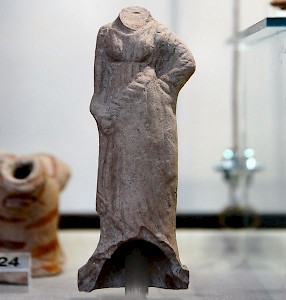Issus (Kinet Höyük)
Q1360503Issus (Hittite Izziya, Greek ᾽Ἱσσός): town in southern Turkey, best known for the famous battle in November 333 BCE, in which Alexander the Great defeated Darius III Codomannus. The town has been identified with the ruins near modern Kinet Höyük.

Kinet Höyük is situated between the former estuary of the Deliçay river and a small natural harbor, about 500 meter from the Mediterranean Sea. People moving from Cilicia to Syria had to pass through Issus before they climbed to the Syrian Gate or the Amanian Gate, the two main passes across the Amanus Mountains.
The site was already inhabited in the late Neolithic, about 5000 BCE, and remained occupied during the Bronze Age, the Hittite period (c.1400-c.1200), the Iron Age (c.1200-c.540), the Persian period (c.540-333), and the Hellenistic Age (333-c.50 BCE). Several strata can be discerned in the hill, which is now about twenty-six meter high.
Although the presence of some monumental architecture is certain, many more ordinary houses -usually made of mud brick- have been identified, and most finds are household items, which are not really special. the popular figurine of the naked goddess holding her breasts has been found several times in Bronze Age, Iron Age, and Hellenistic contexts, suggesting a continuous cult for an Aphrodite-like deity. There's a nice kiln from the sixth century, proving that there were artisans living in the town. It is interesting to note that after the mid-sixth century, murex shells disappear from the site, which suggests that the Persians did not appreciate a purple industry outside Phoenicia.
So far, no mill stones have been found, which suggests that cereals were not processed in the city but on the land; Issus always was a real city and not an agricultural town. Fish, diary products, and several types of meat were also part of the diet. Copper was imported from Cyprus; other ores were found in the Taurus. Transporting these metals to Assyria and its successor empires (Babylonia and Persia) must have been the main source of wealth.
On 5 or 6 November 333, Alexander the Great's Macedonian army passed through the city. Several wounded soldiers were left behind. Not much later, the Persian king Darius III Codomannus took the city; on that same day, he was defeated by the Macedonians, several kilometer south of Issus. After his victory, Issus was called Nicopolis ("victory city"), and a new city was founded: Alexandria near Issus. Because the river on which Issus was founded was slowly silting up, Alexandria would eventually eclipse Issus, which appears to have been abandoned in c.50 BCE, perhaps after an earthquake.
Still, the site was not completely given up. In 194 CE, the Roman emperor Septimius Severus defeated his rival Pescennius Niger near Issus, and a triumphal arch with a quadriga was erected in or near Nicopolis. The Sasanian king Shapur I claims to have occupeied the town in 260. There must have been some settlement, which has not yet been identified by the excavators.
Excavation of Kinet Höyük started in 1992.